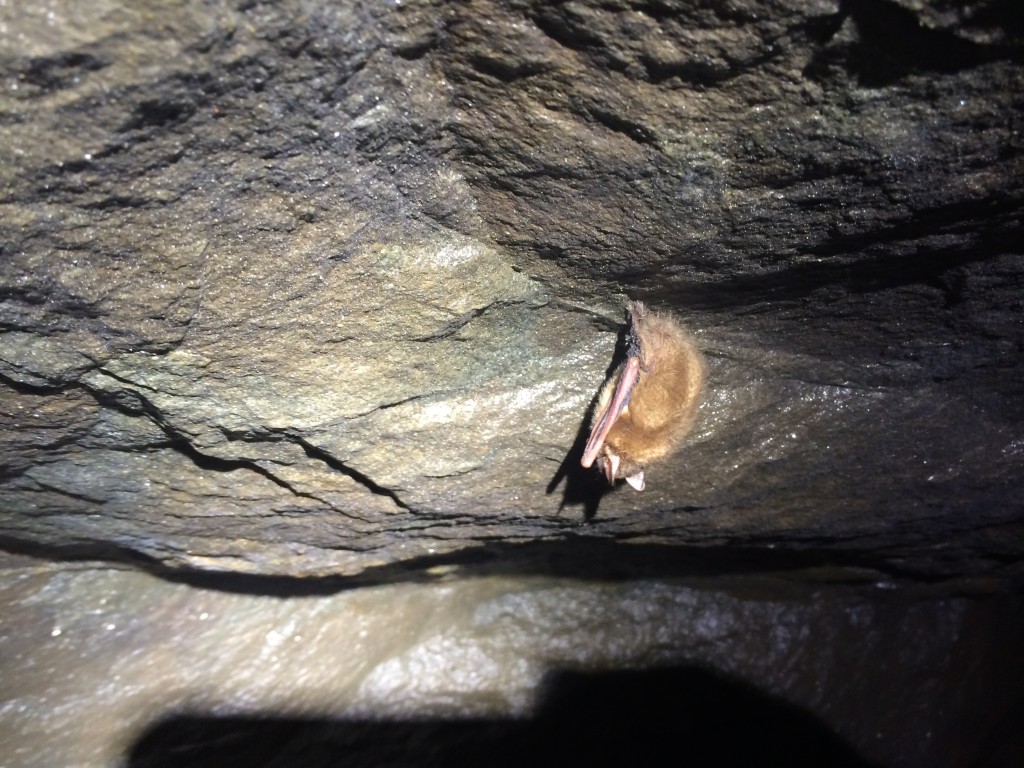 A tri-colored bat found hibernating in the Durham cave
A tri-colored bat found hibernating in the Durham cave
Click to help Heritage Conservancy save our bats!
Heritage Conservancy recently discovered a glimmer of hope at its bat hibernaculum in Durham Township, PA.
Last month, the Pennsylvania Game Commission performed its biannual survey of the Durham bat hibernaculum, which resides on a 90-acre preserved property that was acquired in 2002 by Heritage Conservancy for the purpose of ensuring the protection of the bat population’s hibernating haven. In April 2013, Heritage Conservancy reported on the alarming news that virtually all of the bats in the Durham mine had been wiped out due to White Nose Syndrome (WNS).
WNS is the result of a white, cottony fungus on the nose and wings that irritates bats and causes them to lose their fat reserves. Making it nearly impossible for them to survive a winter in hibernation, they eventually leave their hibernaculum in search of food during unbearable temperatures and either starve or freeze to death.
White Nose Syndrome was confirmed at the Durham bat cave in the fall of 2009. In 2008, it was estimated that the cave hosted 8,000-10,000 healthy hibernating bats, including all bat species native to PA except for the Indiana bat, and population numbers were increasing yearly. During the 2013 survey of the Durham mine, only 23 bats were found hibernating in the cave.
During this month’s survey, 13 bats were found. There are seven vertical depth levels within the mine, and Shannon Fredebaugh, Heritage Conservancy’s Volunteer Coordinator, along with biologists from the PA Game Commission traversed through each one, sometimes having to crawl through narrow, dark spaces to get to the next chamber—certainly not an exciting activity for the claustrophobic! Bats were found scattered throughout various sections of the mine.
Although the numbers remained low, a promising sign is the increase in bat species that were found. The species that Heritage Conservancy and the PA Game Commission discovered hibernating in the mine were little browns, big browns, tricolored, and eastern small-footed. The little browns have been hit the hardest by WNS because of their small size and inability to store enough fat reserves to make it through a winter while infected. The eastern small-footed bat, which is a PA state-threatened species, wasn’t even found in the mine during the 2013 survey. These signs could hint at a possible rebound in the future.
Another small hint at possible recovery is the stabilization in numbers during summer bat counts around the area. This suggests that bats might be adjusting their behavior and hibernating in different areas than in previous years, possibly even in warmer climates farther south.
We should all hope for a rebound. The ramifications of the decline in bat populations could take a devastating toll on our ecosystem. One bat eats about 800,000 to one million insects per year; without bats to control pest levels, insects will fly rampant. As a keystone species, no other animal can fill the critical role that bats play in our ecosystem. Farmers will have little help from bats in repelling bugs, which could increase the use of insecticides. With insects like mosquitoes that carry disease, we could see an increase in human disease contractions like those from West Nile virus.
Heritage Conservancy is doing its part to help bats with their plight. The organization gated the cave at both entry points to prevent intruders from coming in and disturbing the bats while allowing for the bats to come and go freely. Also, through monitoring and stewardship of the mine and its surrounding area, the Conservancy provides good habitat for them.
“The over 90 acres of preserved land that surrounds the Durham bat mine includes wooded habitat and waterways. These resources provide bats with the means to survive right when they awake from hibernation in springtime, which in turn increases their chance to bear young and repopulate the colony,” says Shannon Fredebaugh. “Hopefully, Heritage Conservancy’s commitment here will help with their future recovery.”
To learn more, contact us at 215-345-7020.